×
|
circa
560 B.C.
1. The Bible condemns witches.  |
Exodus and Leviticus, two Old
Testament books that make up part of the "Law of Moses" and the primary
history of the Jewish people, were written in the sixth century B. C by
a Jewish writer—whose
name we do not know. The books, which include
the
passages quoted above that assume the existence of
witches and urge that they be killed, were most likely written in
what is
present-day
Iraq during the reign of Evil
Merodach, a dark time of Jewish exile, around 560 B.C. The
author was
most
likely a priest, and might have been assisted in his work by other
priests and
scribes.
The word "witch" in Exodus is a translation of the Hebrew word "kashaph," which comes from the root meaning "to whisper." The word as used in Exodus probably thus meant "one who whispers a spell." In context, the Exodus passage probably was intended to urge Jews to adhere to their own religious practices and not those of surrounding tribes. |
|
circa
420
2. St. Augustine argues witchcraft is an impossibility Saint Augustine of Hippo, an influential theologian in the early Christian Church, argued in the early 400s that God alone could suspend the normal laws of the universe. In his view, neither Satan nor witches had supernatural powers or were capable of effectively invoking magic of any sort. It was the "error of the pagans" to believe in "some other divine power than the one God." Of course, if witches are indeed powerless, the Church need not overly concern itself with their spells or other attempts at mischief. The late medieval Church accepted St. Augustine's view, and hence felt little need to bother itself with tracking down witches or investigating allegations of witchcraft. |
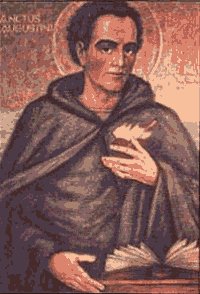 Saint Augustine |
|
1208
3. Satan becomes sinister following Pope Innocent III's attack on Cathar heretics. 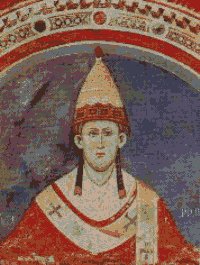 Pope Innocent III |
In 1208, Pope Innocent III
opened an attack on Cathar heretics who believed in a world in which
God and Satan, both having supernatural powers, were at war. The
Church attempted to discredit the Cathar belief by spreading stories
that the heretics actually worshiped their evil deity in person.
Propagandists for the Church depicted Cathars kissing the anus of Satan
in a ceremonial show of loyalty to him. As a result of the
Church's sustained attacks, the public's understanding of Satan moved
from that of a mischievous spoiler to a deeply sinister force.
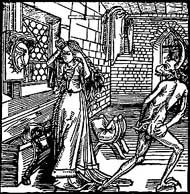 |
|
1273
In Summa Theologian, a Dominican monk named
Thomas Aquinas made his case for the existence of God. In his
work, much of which became adopted as the orthodoxy of the Church,
Aquinas argued that the world was full of evil and dangerous
demons. Among other things, Aquinas argued, these demons had the
habit of reaping the sperm of men and spreading it among women.
In Aquinas's mind, sex and witchcraft begin what will become a long
association. Demons thus are seen as not merely seeking their own
pleasure, but intent also on leading men into temptation. 4. Thomas Aquinas argues that demons exist that try to lead people into temptation. |
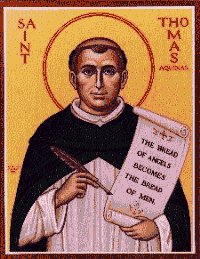 |
|
mid-1400s
5. Witchcraft trials erupt in Europe 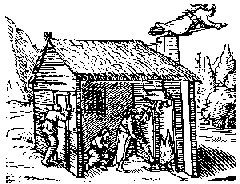 |
Many adherents of Catharism, fleeing a papal inquisition launched against their alleged heresies, had migrated into Germany and the Savoy. Torture inflicted on heretics suspected of magical pacts or demon-driven sexual misconduct led to alarming confessions. Defendants admitted to flying on poles and animals to attend assemblies presided over by Satan appearing in the form of a goat or other animal. Some defendants told investigators that they repeatedly kissed Satan's anus as a display of their loyalty. Others admitted to casting spells on neighbors, having sex with animals, or causing storms. The distinctive crime of witchcraft began to take shape. |
|
1484
6. Pope Innocent VIII and Malleus Maleficarum Pope Innocent
announced that satanists in Germany were meeting with demons, casting
spells that destroyed crops, and aborting infants. The pope asked
two friars, Heinrich Kramer (a papal inquisitor of sorcerers from
Innsbruck) and Jacob Sprenger, to publish a full report on the
suspected witchcraft. Two years later, the friars published Malleus maleficarum ("Hammer of
Witches") which put to rest the old orthodoxy that witches were
powerless in the face of God to a new orthodoxy that held Christians
had an obligation to hunt down and kill them. The Malleus told frightening tales of
women who would have sex with any convenient demon, kill babies, and
even steal penises. (The friars asked, "What is to be thought of
those witches who collect...as many as twenty or thirty members
together, and put them in a bird's nest or shut them up in a box, where
they move themselves like living members and eat oats and corn?")
Over the next forty years, the Malleus
would be reprinted thirteen
times and come to help define the crime of witchcraft. Much of
the book offered hints to judges and prosecutors, such as the authors'
suggestion to strip each suspect completely and inspect the body to see
whether a mole was present that might be a telltale sign of consort
with demons, and to have the defendants brought into court backwards to
minimize their opportunities to cast dangerous spells on officials.
|
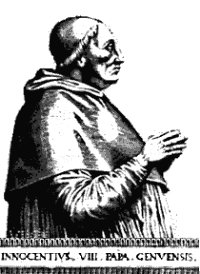 Pope Innocent VIII Image of Malleus manuscript |
|
early
to mid-1500s
7. The Reformation sends kill rates up 
|
Outbreaks of witchcraft hysteria, with subsequent mass executions, began to appear in the early 1500s. Authorities in Geneva, Switzerland burned 500 acccused witches at the stake in 1515. Nine years later in Como, Italy, a spreading spiral of witchcraft charges led to as many as 1000 executions. The Reformation divided Europe between Protestant regions and those loyal to the Pope, but Protestants took the crime of witchcraft no less seriously--and arguably even more so--than Catholics. Germany, rife with sectarian strife, saw Europe's greatest execution rates of witches--higher than those in the rest of the Continent combined. Witch hysteria swept France in 1571 after Trois-Echelles, a defendant accused of witchcraft from the court of Charles IX, announced to the court that he had over 100,000 fellow witches roaming the country. Judges responding to the ensuing panic by eliminating for those accused of witchcraft most of the protections that other defendants enjoyed. Jean Bodin in his 1580 book, On the Demon-Mania of Sorcerers, opened the door to use of testimony by children against parents, entrapment, and instruments of torture. Over the 160 years from 1500 to 1660, Europe saw between 50,000 and 80,000 suspected witches executed. About 80% of those killed were women. Execution rates varied greatly by country, from a high of about 26,000 in Germany to about 10,000 in France, 1,000 in England, and only four in Ireland. The lower death tolls in England and Ireland owe in part to better procedural safeguards in those countries for defendants. |
|
1591
8. King James authorizes the torture of suspected witches in Scotland Scotland's witch-hunting had its origins in the marriage of King James to Princess Anne of Denmark. Anne's voyage to Scotland for the wedding met with a bad storm, and she ended up taking refuge in Norway. James traveled to Scandinavia and the wedding took place in at Kronborg Castle in Denmark. After a long honeymoon in Denmark, the royal newlyweds encountered terrible seas on the return voyage, which the ship's captain blamed on witches. When six Danish women confessed to having caused the storms that bedeviled King James, he began to take witchcraft seriously. Back in Scotland, the paranoid James authorized torture of suspected witches. Dozens of condemned witches in the North Berwick area were burned at the stake in what would be the largest witch-hunt in British history. By 1597, James began to address some of the worst prosecutorial abuses, and witch-hunting abated somewhat. |
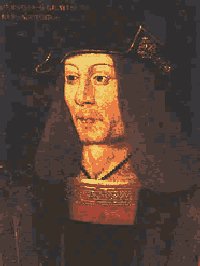 King James VI of Scotland (later King James I of England) |
|
1606
9. Shakespeare's Macbeth performed  Banquo and Macbeth are greeted by the three witches. |
As an indication of the attention witch-hunting had begun to attract in England during the executions in the era of King James, Shakespeare wrote a play, Macbeth, in which strange, bearded, hag-like witches play prominent roles. A dark Cave. In the
middle, a Cauldron boiling. Thunder. Enter the three witches. |
|
1640s
10. Witch-hunting, after a major outbreak in France, begins to decrease. In
1643-1645, the largest witch-hunt in French history occurred.
During those two years there were at least 650 arrests in Languedoc
alone. The same time was one of intense witch-hunting in England,
as the English civil war created an atmosphere of unrest that fueled
the hunting, especially under Matthew Hopkins. The Thirty Years
War, a conflict that raged in several European
states from 1618-1648 following an attempted rebellion by
Protestants in Bohemia from the Roman Catholic Hapsburg rulers,
produced slaughter and suffering that sparked additional witch hunts.
The number of trials began to drop sharply, however, in the late 1640s. Holland, for example, was by 1648 a tolerant society that had done away with punishments for witchcraft. |
 Burning witches at the stake. |
|
1682
11. England executes its last witch  Lord Chief Justice Sir Francis North |
In 1682, Temperance Lloyd, a senile woman from Bideford, became the last witch ever executed in England. Lord Chief Justice Sir Francis North, a passionate critic of witchcraft trials, investigated the Lloyd case and denounced the prosecution as deeply flawed. Sir Francis North wrote, "The evidence against them was very full and fanciful, but their own confessions exceeded it. They appeared not only weary of their own lives but to have a great deal of skill to convict themselves." North's criticism of the Lloyd case helped discourage additional prosecutions and witch-hunting shifted from one side of the Atlantic to the other, with the outbreak of hysteria in Salem in 1692. The Enlightenment, beginning in the late 1680s, contributed to the end of witch-hunts throughout Europe. The Enlightenment brought empirical reason, skepticism, and humanitarianism, each of which helped defeat the superstitions of the earlier age. The Enlightenment suggested that there was no empirical evidence that alleged witches caused real harm, and taught that the use of torture to force confessions was inhumane. |